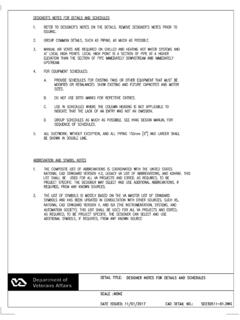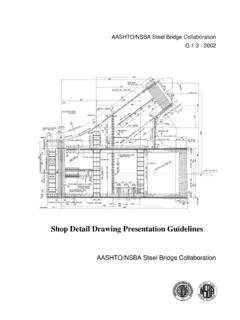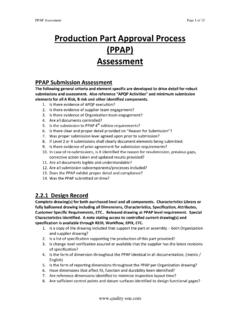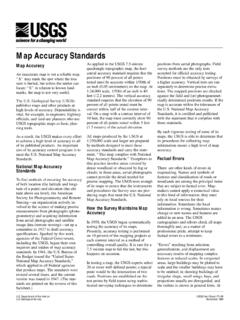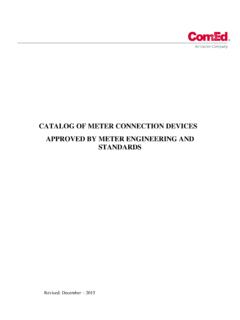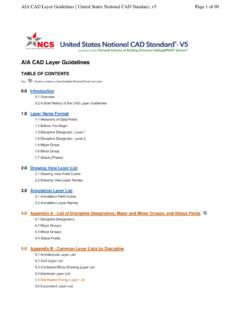Transcription of PISA-BASED TEST FOR SCHOOLS SAMPLE TEST ITEMS - OECD
1 PISA-BASED TEST FOR SCHOOLS SAMPLE TEST ITEMS The OECD released a selection of SAMPLE test ITEMS from the assessment in an interactive, online format. The SAMPLE test ITEMS include questions at each proficiency level for each testing domain (reading, mathematics and science). These ITEMS were not used in the actual assessment, but they were used in the pilot of the assessment. This document contains the ITEMS used to populate the SAMPLE test ITEMS website, which allows users to answer these PISA-BASED Test for SCHOOLS questions, discover their level of difficulty, and the concepts being tested. READING 2 QUESTION LEVEL 1: FREE FREE! BUT AT WHAT PRICE? Imagine you are in a shop and you are offered a choice of two gift vouchers. Which one would you go for? Try to decide quickly! A 10 gift voucher for FREE! A 20 gift voucher for 7 If your first instinct is the same as absolutely everyone in a study carried out by Shampan'er and Ariely in 2006, you'll take the first option, the free option.
2 Economically, though, this doesn't make any sense. When you look at it you can see that the 20 gift voucher is actually better value: you really get a 13 gift voucher for free. However, this is camouflaged by the way the offers are worded. The word free just shakes all rationality out of us. Now compare these two offers and decide which you'd prefer: A 10 gift voucher for 1 A 20 gift voucher for 8 Now if you're like the majority of people (64%) in Shampan'er and Ariely's study you'll go for the 20 gift voucher. Notice that this time the price of each gift certificate has only been increased by 1. The 10 gift voucher has gone from 0 to 1 and the 20 gift voucher has gone from 7 to 8. Yet without the word 'free', most people suddenly realise that the 20 deal is superior, and decide to pay out for a better return. So be aware of the seductive power that 'free' holds over your mind and you might decide you d rather pay the price QUESTION According to the text, what effect does the word free have on consumers ability to make decisions?
3 A It prevents them from making decisions. B It slows down their decision-making. C It makes their decisions more thoughtful. D It makes their decisions less thoughtful. READING 3 PRINT READING QUESTION (LEVEL 1) THE CORRECT ANSWER IS: (D) IT MAKES THEIR DECISIONS LESS THOUGHTFUL. QUESTION LEVEL Students at Proficiency Level 1 are capable of locating pieces of explicitly stated information that are rather prominent in the text, recognising a main idea in a text about a familiar topic, and recognising the connection between information in such a text and their everyday experience. Typically the required information in texts at this level is prominent and there is little, if any, competing information. The reader is explicitly directed to consider relevant factors in the task and in the text. NATURE OF THE TASK Draw inferences to identify the main idea in an exposition The situation is personal. The question belongs to the exposition text type category because it is the type of text in which the information is presented as composite concepts or mental constructs, or those elements into which concepts or mental constructs can be analysed.
4 READING ASPECT The aspect is integrate and interpret form a broad understanding because the individual has to focus on relationships within the whole text. SCORING Full credit: D. It makes their decisions less thoughtful. No credit: Other or missing. READING 4 QUESTION LEVEL 2: INDIAN MYSTIC Indian Mystic Claims Not to Eat for 70 Years By Benamin Radford, LiveScience An 82-year-old man in India is claiming to have not had anything to eat or drink since 1940 and doctors from the Indian military are allegedly studying him to learn his secret. The man, Prahlad Jani, is being observed in a Gujarat hospital. Jani claims to be a breatharian someone who does not need to eat or drink, because he draws nourishment from the air and from meditation. As remarkable as his story is, Jani is not the first, nor the only, person to claim such a supernatural power. The claim that people can live without food or water is called inedia, and is actually somewhat of a common claim among religious fakirs of India.
5 Unfortunately, none of the cases have withstood scientific scrutiny. The human body needs both food and water to function; it's as simple as that. It's easy for anyone to claim that he or she has not had anything to eat or drink for the past few weeks or months (or years). But unless the person has been carefully and continuously watched during that time, it's impossible to prove the assertion. Several people who have claimed to survive without food or water were later caught eating and drinking. It can take only a few seconds to eat something, and other than in specific areas such as prisons, conducting a close around-the-clock surveillance on a person is not easy. Often the person will ask for privacy to sleep or go to the bathroom (which is suspicious in its own right) and then snack surreptitiously. One well-known breatharian advocate in the 1980s, a man named Wiley Brooks, claimed he did not eat yet was caught consuming junk food. This is not the first time that Jani has made this claim.
6 He was examined in 2003 for about a week, during which time, he apparently did not eat or exercise but he did lose weight. If Jani's abilities are real, it seems odd that he would lose weight during the time that his food intake was being monitored. If he truly gets all the sustenance he needs from air and meditation, there's no reason he would lose weight when he doesn't eat. Reports claim that Prahlad Jani "has now spent six days without food or water under strict observation and doctors say his body has not yet shown any adverse effects from hunger or dehydration." Assuming the claim is true and it's not clear just how strict the observation is Jani's inedia so far remains unproven. If he really doesn't need food or water, he should be under close observation for months or years to prove it. Given that he claims not to have consumed anything since World War II, this shouldn't be a problem.
7 QUESTION What is the author s attitude towards the idea that people can survive without food and water? Give a reason for your answer by using information from the article. Type your answer here: READING 5 PRINT READING QUESTION (LEVEL 2) THE CORRECT ANSWER: REFERS TO THE IDEA THAT THE AUTHOR DOES NOT BELIEVE IN INEDIA AND PROVIDES EVIDENCE TO SUPPORT THIS. QUESTION LEVEL Students at Proficiency Level 2 are capable of tasks that require the reader to locate one or more pieces of information, which might need to be inferred and might need to meet several conditions. Other tasks at this level require recognising the main idea in a text, understanding relationships, or construing meaning within a limited part of the text when the information is not prominent and the reader must make low-level inferences. Tasks at this level may involve comparisons or contrasts based on a single feature in the text. typical reflective tasks require readers to make a comparison or several connections between the text and outside knowledge, by drawing on personal experience and attitudes.
8 PISA considers Level 2 a baseline level of proficiency at which students begin to demonstrate the reading skills and competencies that will allow them to participate effectively and productively in life as they continue their studies, and as they enter into the labour force and become members of society. NATURE OF THE TASK Identify an author s attitude in a persuasive text The situation is personal. The question belongs to the argumentation text type category because it is the type of text that presents the relationship among concepts or propositions. Argument texts often answer why questions. READING ASPECT The aspect is integrate and interpret develop an interpretation because the individual has to focus on relationships between parts of the text. SCORING Full credit: Refers to the idea that the author does not believe in inedia and provides evidence to support this. May quote directly from the text. No credit: Gives an insufficient or vague response; shows inaccurate comprehension of the material or gives an implausible or irrelevant response; or missing.
9 READING 6 QUESTION LEVEL 3: WRITING A TRAVEL ARTICLE Let s say I want to write an article expressing my conviction that Croatia is the next big destination for travellers. First, I d ask myself why I feel this way. Well, let s see: it s beautiful, it has a rich history, the people are warm and it s great value. I ve isolated four salient points to support my theme, so the next question is order of importance. To organise my story in terms of accelerating emotional connection, I ll lead with the point about value for money as it s the least emotional and most practical or logical consideration. History begins to involve the heart but is still fundamentally intellectual, so that would be second. Beauty is a more emotional consideration, drawing readers into the story via their soul. The people connection represents what I think is the climax of my trip, and the climax of travel itself, so that would come last. My final point is the top of the pyramid, but every step along the way contributes to my story s overall resonance and effectiveness.
10 Next, I ll search through my notes and draw out the experiences that brought these points to life. The hostel in Dubrovnik that cost just 15 a night, or that extraordinary meal under the stars that was 5. That s where I learned how inexpensive the place was, relatively speaking. The historical richness of the country came to life in Dubrovnik, when I walked along the walls of the old city and saw old roof tiles shattered during the war lying side by side with new roof tiles built to replace them a poignant reminder of the constant presence of the past, but also an inspiring example of how tourism can help rebuild a place. Croatia s beauty was obvious: the rocky coast and the shadowing cypresses, the wildflowers in bloom and not a person in sight. And then it all came together for me on my last night in Dubrovnik, when I went out to dinner with a local tour guide and she told me about how her family had suffered during the war, how the entire country had suffered, but there was now new hope blooming in the land.










